If you have made a deliberate decision to secure your suburban area water, it is best to use wells. Wells can be drilled on your own and if you intend to do this, then this article will come in handy. But better installation water supply systems should be entrusted to specialists, because it requires considerable experience and knowledge.
Choosing a location for a well
To begin with, we must choose the right place for the future well so that it is as efficient as possible. We need to determine if the site has a shallow aquifer, for which there are certain signs.
Signs of a shallow aquifer present on the site
- A lot of plants have accumulated in a particular area of \u200b\u200bthe site, preferring high humidity.
- In the evening, fog and dew accumulate in areas with an increased amount of vegetation, and in winter time thawed patches form in the snow.
- going to a large number of mosquitoes and other insects. It is also believed that cats prefer to rest in places located above deep waters.
If at least one of these signs has been noticed, then you can safely proceed to drilling the well. These are all, of course, signs of more folk, more effective way revealing deep waters is a geological study.
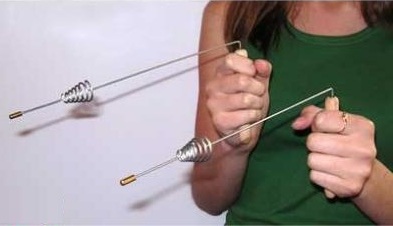
Tools that will be required during the drilling process
We’ll make a reservation right away that not all tools can be made with your own hands, some of them will have to be bought. If we manage to make, for example, a drill, then its quality will be doubtful, because standard factory drills are made of high-strength hardened steel.
At work we will need:
- Derrick;
- Drilling column, to which couplings for connection are attached;
- Drill head;
- boards;
- Rope;
- Filter.
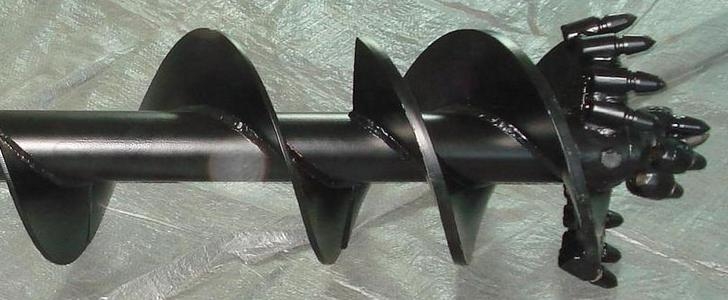
The drilling rig is a kind of tripod that you can assemble with your own hands from thick logs Ø15 centimeters. Between two of them we attach a winch, to which we hang the drill column with a rope. The column is a structure of rods interconnected by couplings and threads. There should be 6 rods in total, their length is from 1.5 to 3 meters.
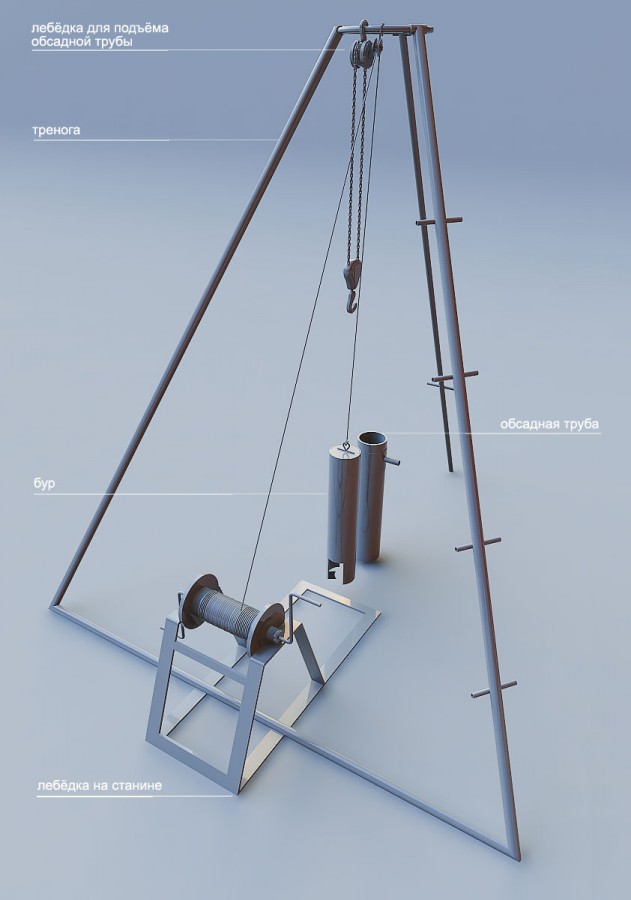
The boards will be useful to us so that the walls of the pit do not crumble (we will talk later what it is). Drill heads are various kinds and are applied depending on the type of soil. Much depends on this type, up to the method of drilling a well.
Types of drill heads
Drill heads are of the following types:
- a chisel used to split hard rocks;
- bailer - it removes the soil left after the operation of the bit (you can also drill loose soil with the bailer);
- a spoon that is used for sand and clay;
- a coil will be needed if gravel is present in the soil;
- spoon with serpentine.
We have selected the tools, we proceed directly to drilling.
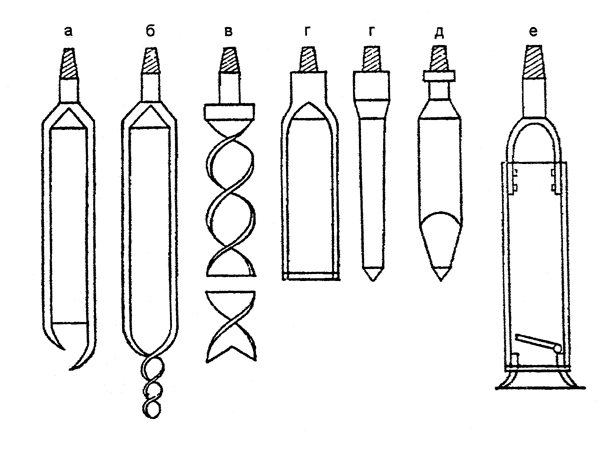
Rope drilling technology
The percussion-rope method of drilling consists of the following stages.
Stage 1. Pre-instruction. Before starting work, we must understand that the optimal depth of the well is 7-10 meters. You can drill no more than 20 meters on your own, if the groundwater is at a greater depth, then specialists must definitely do the drilling.
Important! It is impossible to drill a well on your own in any case, since at least two assistants will be needed for this.
Stage 2. Align the pit (rectangular "box") in the place where the well will be located. The dimensions of the pit should be 2x1.5x1.5 m, and it is needed so that unstable upper layers of soil do not crumble. We take the boards and make the lining of the walls of the pit.
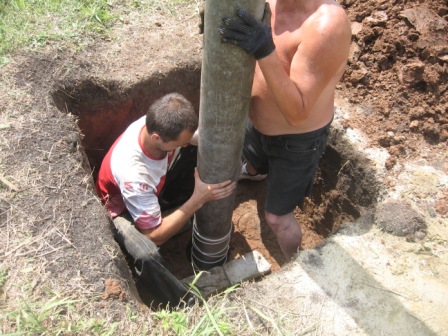
Stage 3. We mount the tripod at the drilling site. We securely fasten it, then we place the drill column in the hole and turn the rod. The drilling process has begun. Every 60-70 centimeters we clean the column from adhering earth.
Stage 4. When we reach the aquifer, the drill column should be pulled out, and the filter should be lowered instead. We will definitely use the filter, otherwise the water pump will quickly become unusable. The voids formed between the walls of the well and the filter are covered with sand. Then we install pipes through which water will rise, and dismantle the walls of the pit. We fill up the well.
Stage 5. We install a water pump, which will be the "core" of the entire well. Outwardly, it will not look very attractive, so it is advisable to decorate it with some kind of decorative element, for example, a canopy.
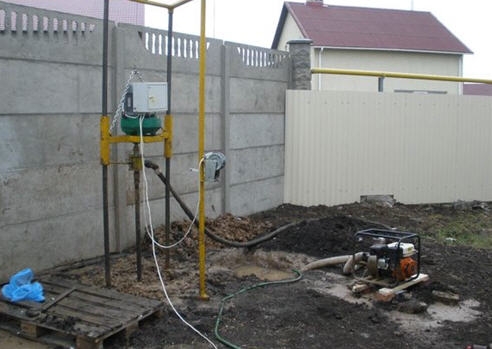
In this way, we can drill a well up to 20 meters. Water located at such a depth has repeatedly passed through natural filtration, it will be clean and soft.
Well pipes and filter
The well filter is the same important detail like a pump. There are the following types of filters:
- gravel;
- Wire;
- Reticulate.
During operation, it is desirable to fill the filter with gravel, which will prevent dirt from entering the pipeline. When choosing a filter, we must pay attention to the following parameters:
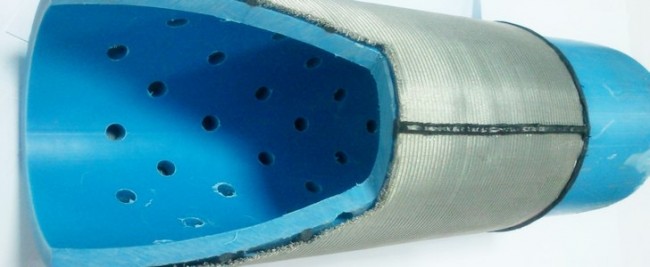
Options for arranging pipes for water lifting
- If water is to be consumed for food, then we must use plastic pipes that do not corrode. If finances allow, you can buy more expensive enameled steel pipes.
- If the well is intended for economic purposes, then we can use socket, thin-walled or threaded pipes.
Drilling a well using a pump
This method is perfect if the depth ground water does not exceed 10 meters. It is no less effective than the previous one.
Stage 1. We dig a hole 1.5 meters deep in order to remove loose and unstable upper layers of soil. The area of such a pit should be approximately 1 square meter. We upholster its walls with boards so that it is convenient to work.
Stage 2. We take a steel pipe and cut one end of it with teeth, like on a hacksaw. We unbend the teeth in different directions. At the other end, we make a thread for connecting to pipes. Next, using clamps, we equip the pipe with handles so that you can hold it vertically. On about steel pipes ah, we also do carving, but on both sides. Each pipe should be approximately 3 meters long.
Stage 3. We take a pre-prepared container of at least two hundred liters filled with water, a medium power water pump, as well as a hose that will reach the bottom of the pit. All pipes should have Ø12 cm, more if possible.
Important! This procedure is also not overpowered, you must have at least one assistant.
Stage 4. We insert the pipe into the pit to the maximum possible depth. We turn on the pump. The pressure of the water will erode the soil under the pipe, and it will gradually sink. It is desirable to constantly rotate the pipe at the same time.
Stage 5. The water will overflow from the pipe, but it can be reused by straining through a sieve. When the pipe is completely deep, we attach the next one to it and continue to work until the aquifer is reached. Then we remove the boards and bury the hole, and attach a cover to the end of the pipe, which will prevent debris from entering the system.
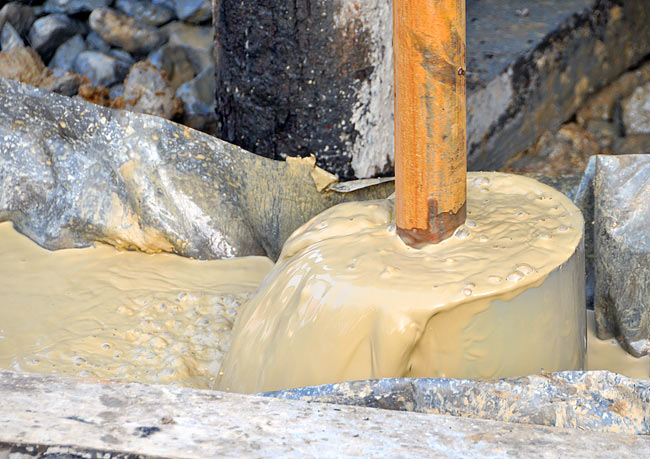
This is the easiest way to drill a well, but there are others.
A shallow well for economic purposes
If water is needed, for example, for watering a garden, then a well for this can be made using a conventional hand drill. The only condition is that the upper water table must be a maximum of three meters from the surface. If the length of the hand drill is not enough, then we build it up with reinforcing bars or small metal pipes.
We pass through the hardest layers of the earth with an additional load that clings to the handle of the drill. So the load on the hands will be less.
Important! The water extracted from such wells is not suitable for drinking, since it did not pass natural filtration!
If branches or roots come across during drilling, then we cut them down with an ax, previously attached to a long iron bar. After about two meters, wet sand will start to come across, so every 10 centimeters the drill will have to be pulled out for cleaning, otherwise we may break the device.
![]()
When the sand takes on a bluish tint, it will mean that we are almost there. When the first water appears, the drill can no longer be used, because it will no longer give anything - the liquid soil will not hold on to the blades. We just have to insert the casing pipe - a shallow well is ready!
To lift the water, we will use a conventional electric pump.
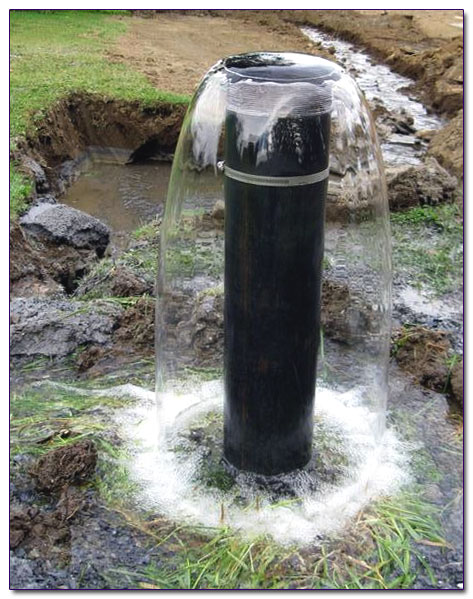
As a conclusion
Production drills are striking in their scale, which is why the very idea of drilling a well with our own hands seems stupid and impracticable to us. But those of you who have read the article already know that this is, to put it mildly, an exaggeration. All we need is a drilling tool, Additional materials, a bit of skill and, of course, patience.

Folk "method of detecting deep waters




Private property is not only abundance clean air and silence, but also the need to create individual communications for a decent living in the house. One of the most demanded is water supply. For these purposes, a do-it-yourself water well (but not artesian) is widely applicable today.
A source found in soil layers can serve from 5 to 100 years, depending on the depth of its occurrence and the total flow rate of the well (an artesian source serves the maximum). Therefore, we will consider the methods of a well with our own hands on the site. And we will reveal to you several methods of self-drilling.
Important: self-drilling is possible only with sand wells. Artesian sources on the site require complex technical equipment and paperwork. You can't do it with your own hands.
screw method
If you wondered how to drill a well with your own hands on the site and at the same time want to equip a well on sand, then this soil development method is the easiest. To carry out the work you will need:
- Auger with extension pipe;
- Casing pipes for the entire length of the well;
- Mesh filter;
- Pump (surface or submersible, depending on the flow rate of the well and your water needs).
First of all, it is worth deciding on a place for a well. It is very important to consider the lowest point of the well on the site. It is here, according to the laws of geodesy, that underground water accumulates. It is also important to take into account the depth of the aquifer. Ask your neighbors about this. After all, if the reservoir with water is located lower than 20 meters, then you cannot cope with your own hands.
Before you make a well, consider the location of unwanted objects relative to the future source. Neighboring septic tanks are dangerous, industrial enterprises etc. Water from such a neighborhood will be pretty spoiled by harmful chemical compounds.
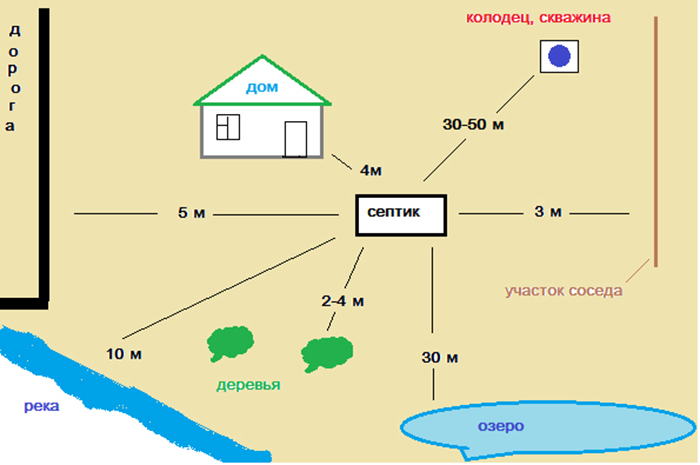
So, let's get down to direct drilling:
- The auger must be rotated clockwise in four hands. That is, you need an assistant. We turn the drill until it is completely deepened into the ground, after which we take it out with a winch. We clean the blades from the layers of soil and deepen the drill again.
- Thus, you need to reach the impervious soil. You can mark this layer by the composition of the wet soil that you have chosen on the aquifer.
Important: a bailer can be used to level the walls of the well and clean it from soil layers.
- The finished well is equipped with a casing pipe with a strainer at the end. Now you need to pump out some water with a pump. Over time, the liquid in the source should go clean. But if after pumping the water is still cloudy, it is worth deepening the well by another 1-2 meters.
You can learn more about creating a sand well with your own hands from the video:
Pipe deep drilling
- If you are wondering how to drill a well yourself, then you can use this method for greater convenience. Here it is necessary to prepare casing pipes, the diameter of which will exceed the diameter of the screw by several centimeters.
- First you need to act according to simple auger drilling. As soon as manual drilling reaches the level of 70-100 cm, you can install a pipe in the hole and deepen it under the influence of impact force using a sledgehammer.
- Drilling of the well continues already inside the pipe. And each time, taking out the auger with a winch, it is necessary to deepen the pipe up to the aquifer.
Important: do not be zealous with clogging the pipe in the bottomhole itself. Otherwise, you can accidentally block access to groundwater in your well. It is also worth noting that this source development method does not include a filter. Therefore, it will be necessary to completely pump out the well several times and only after that give water for analysis.
- It is desirable to fill the annular space with strong cement mortar to prevent dirty groundwater and wastewater from entering the source.
Rope percussion drilling
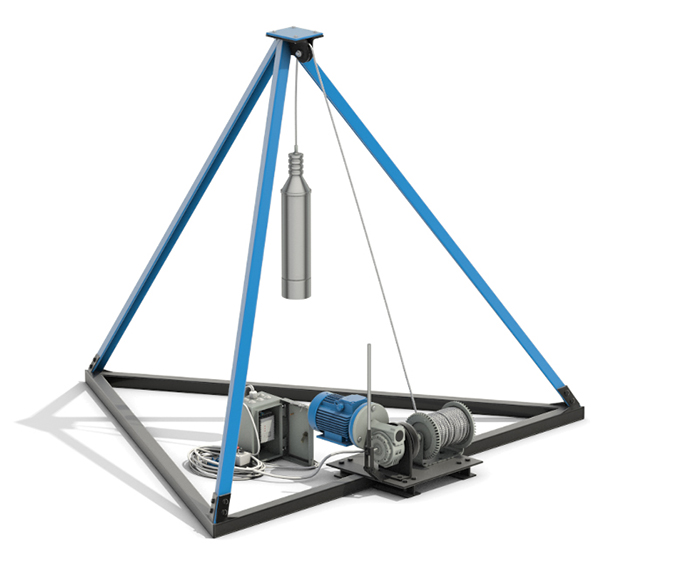
For those who do not know how to drill a well, we also reveal another way to develop a source. This method is the most powerful of all listed. Since the soil will be drilled under the influence of a large impact force. To complete the work you will need:
- Powerful and durable tripod made of metal pipes;
- Winch with steel cable;
- A shock cup made of a steel pipe, weighted and having sections for cutting the soil on one side;
- Bailer;
- Casing pipes with a mesh filter.
- First of all, you need to prepare a special hole for the well. That is, we dig out a platform with dimensions of 1.5x1.5x2 meters. It is advisable to overlay it with boards so that the soil does not crumble into the well during work.
- So, we set the tripod over the intended area so that the impact glass is located exclusively in the center of the tripod. We mount the winch, and we attach the impact glass to the steel cable.
- With the help of a neighbor (friend, brother), we act on the impact cartridge with a winch, sharply lowering the drill. The carving on the glass will cut into the ground, absorbing the cut layers.
- Raise the glass and clean it from the remnants of the soil.
- Thus, you now know how to drill a well without sophisticated equipment.
Important: do not forget about good mesh filters that will prevent sand from entering the well water.
But before you work through the source manually, weigh the pros and cons. It is quite possible that it will be more profitable for your site to drill an artesian source.
Video about percussion drilling:
Autonomous water supply is sometimes simply necessary, since it is very costly to conduct a centralized water supply to every house remote from the highway. But how to drill a well in the country with your own hands, if you don’t have the opportunity to hire a professional drilling team?
We will talk about drilling methods and give detailed guide By independent production works.
Drilling of the wells
Ways
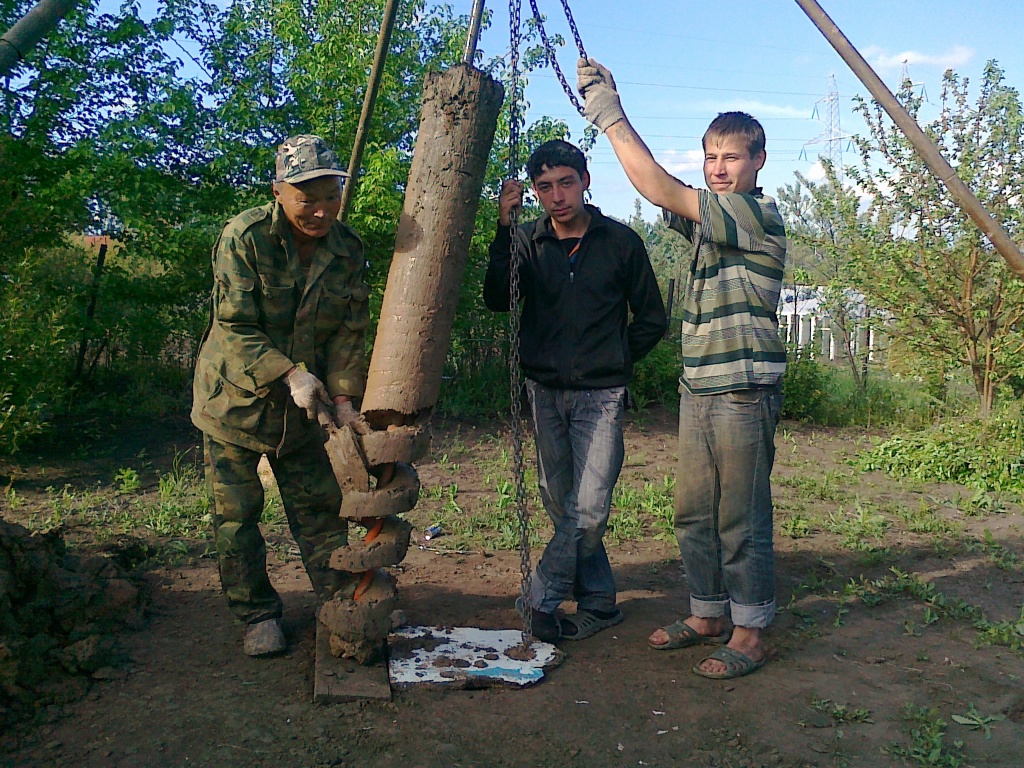
The extraction of water has been of interest to man throughout his history.
Therefore, more than enough methods of drilling wells for water have accumulated, but we will consider only the most relevant options for us, namely:
- Screw (rotary) drilling. For work, an auger is used - the most ordinary Archimedean screw (those who have seen an ice drill must understand), which, when rotated, captures the rock with a spiral strip of hardened steel and delivers it upwards. Allows you to drill shallow wells manually or using a motor drive (depth up to 8 - 12 meters);
- Shock rope method. For work, the force of gravity of the Earth is used: the drill falls from a height and breaks through the rock, which is then taken out with a bailer or a drill glass. The method is quite laborious, but it allows you to manually dig fairly deep wells;
- Abyssinian well. For punching the soil, the so-called "needle" is used - a pipe with a sharp tip and perforation for water intake, which is driven into the ground to the desired depth. To hammer the pipe, you can use a shock woman or a sledgehammer. Depth of slaughter - from 3 to 8 m.
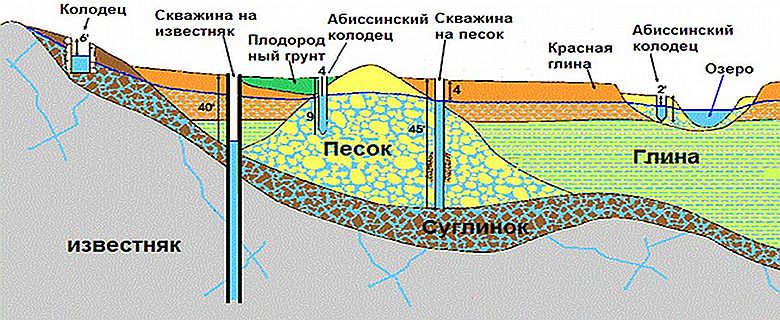
Important!
According to the depth and type of aquifer, three types of wells are distinguished - wells "on sand" (depth up to 50 m), wells "on limestone" (depth up to 200 m) and wells (depth from 3 to 8 m).
Of course, the deeper the more.
The well is different in that water is pumped out of it by surface manual or electric pump. The capabilities of such a device are limited by the height of the water column, so you will not be able to pump out water from a depth greater than 8 meters.
It is most realistic to build a well "on the sand" or an Abyssinian well. Drilling artesian wells (those that are “on limestone”) is a complex and time-consuming task, which is best left to professionals, despite the fact that the price of such work is quite high.
Choice of drilling method

To determine how to properly drill a well, it is necessary to establish at what level the aquifer of the rock is located.
To do this, you can act in two ways:
- To carry out "reconnaissance" among neighbors or fellow villagers - for sure someone will have a well. You can also use a well located nearby and measure the water level in it - this will be the desired value if you are interested in a shallow well;
- Learn all necessary information at the local geodetic office. Such organizations have all the necessary data, but obtaining this information, for known reasons, can be accompanied by red tape.
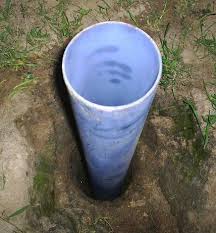
Important!
To drill a well "on the sand" using the auger method, you will need to find out the depth of the water-resistant layer of rock under the sand, since you will have to dig just before it.
This information is needed to determine the number of additional rods to transmit torque to the drill.
So, we found out the depth of the aquifer. If this value does not exceed 5 - 7 meters, then you can use a conventional hand drill (with or without a motor) or hammer in a “needle”. To excavate a well "on the sand", or if the depth is large enough (15 meters or more), it is better to use the shock-rope method of development.
Important!
Drilling with an auger to a great depth is complicated by the fact that after each pass to the length of the screw (500 - 700 mm), the entire string has to be taken out, disassembled, cleaned and reassembled.
It takes the lion's share of time and effort.
The percussion-rope method is also quite slow, but at the same time, the expenditure of forces is less, and the quality of excavation is higher.
Manufacturing jobs
Abyssinian well

The Abyssinian well got its name because of the first place of its mass use - Ethiopia, which was formerly called Abyssinia. Today you can see it in any locality, they call it a column.
The main advantage of such a well is its compactness and the ability to use a mechanical water injection system that works without electricity.
- Determine the location of the well. It does not take up much space and can be installed right in the basement of the house. The only condition is remoteness from septic tanks and compost pits, as well as other sources of soil contamination;

- We take a piece of pipe (length - about 100 - 110 cm) of an inch diameter with a welded cone-shaped pointed tip (needle) and perforation along the surface of the body. We put a mesh of stainless steel wire on the pipe, which we solder with tin or fix with clamps;

- We hammer the segment with a sledgehammer into the ground. We use a wooden overlay so as not to bend the edges. We wind the coupling and attach the next section of the pipe, put a washer on the pipe so that it stops on the coupling. Next, we take a pancake from the bar (the weight depends on your athletic data) and put it on the protruding segment, raise it to the top of the segment and release it down - we hammer the pipe further;
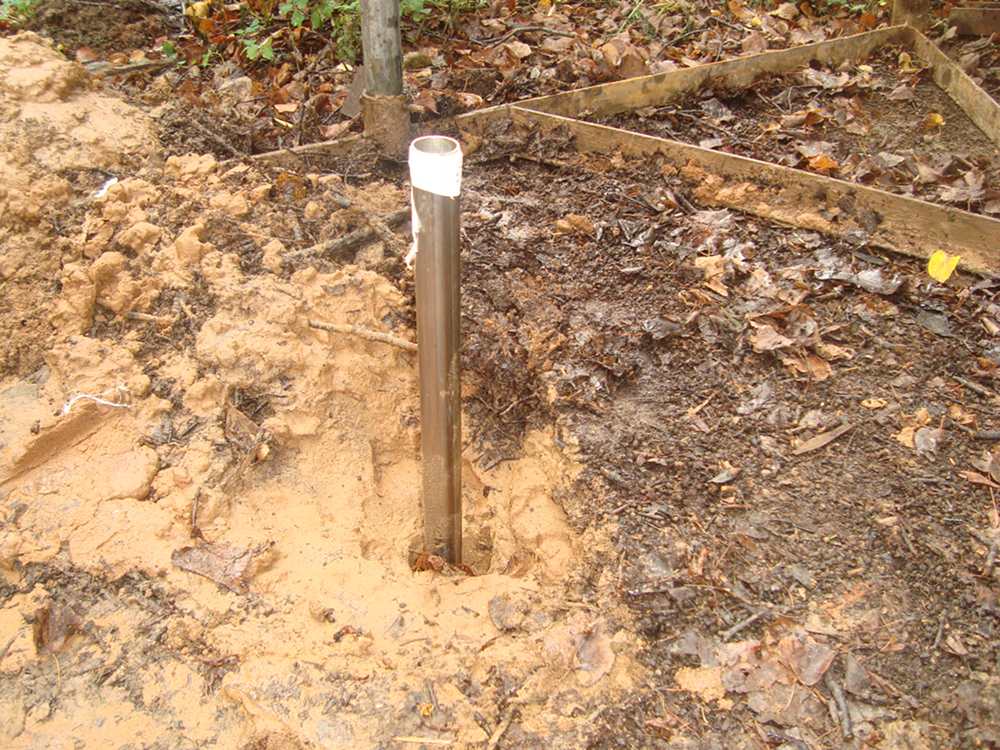
- Next, wind the new segments and also drive them into the ground. When the process suddenly becomes easier, we lower the probe into the pipe and check for moisture. As soon as moisture has appeared, we clog the pipe for another meter;
- We wind the pump on the upper end of the pipe and pump water until it becomes transparent. We take water samples to determine its suitability for drinking; (See also the article.)
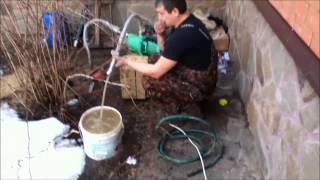
- We concrete the exit point of the pipe, install pumping equipment and connect it to the water supply. In the plumbing system, it is better to have a special sump for additional water filtration.
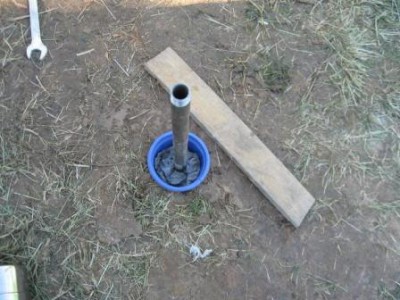
Important!
If the depth of the aquifer is large, or the rock is too hard, an ordinary screw drill can be used to penetrate the soil.
Well by percussion-rope method

If you want to equip a well "on the sand" of a sufficiently large depth, you should use the percussion-rope drilling method. To do this, you will have to assemble a tripod from steel pipes or wooden beams as shown in the photo above.
On the upper edge of the tripod we fix a block through which we pass a steel cable or a strong rope. We hang a drill glass to the free end of the cable, we wind the other end onto a winch or a well gate.
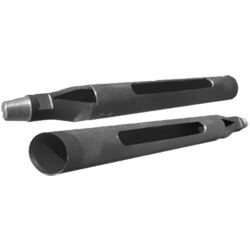
We hammer the glass into the ground and extract it with a winch. We take out the earth and repeat the process, constantly deepening. When the glass goes underground, it should be lifted and thrown under its own weight until it is filled with earth.
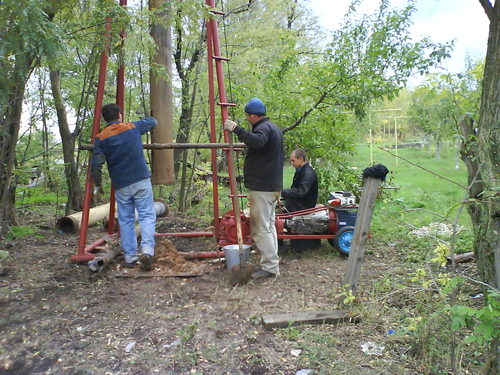
If the rock becomes loose and will not hold in the glass under the action of friction, then we hang the bailer with check valve and extract the breed. For hard layers, we use a chisel, with which we break the layer, and then take it out with a bailer.

When the aquifer goes, we insert a casing pipe with perforation and a steel mesh filter at the end into the well. We mount the next pipe section to it and deepen it. We do this until the pipe string hits the water-resistant bottom of the aquifer of sand.
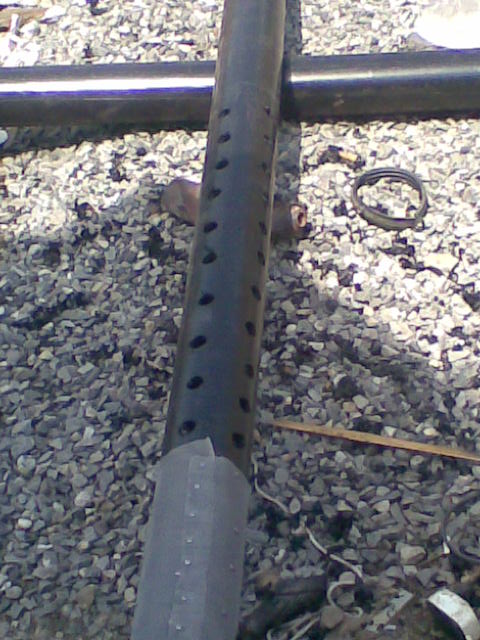
We remove sand and water from the pipe using a bailer of a smaller diameter. If the mixture is too thin, it can be thickened by adding sand or earth. At the bottom of the pipe we fall asleep a layer of gravel with a depth of 20 - 30 cm.
We lower the deep water pump into the pipe and pump the water to a transparent state. Next, we concrete the gap between the walls of the pipe and the well, if necessary, we warm it. We connect the water supply and make a blind area and a canopy over the well to prevent water from entering.

Important!
This instruction is simplified as much as possible and is for informational purposes, for a more detailed study of the issue, read thematic articles on our website.
Conclusion
We showed how to drill a well at home without the participation of professional teams with minimal material costs. For a complete visual impression, we bring to your attention the video in this article.
There is no central water supply in your area and will not be. Or is it just planned. The construction of a well is very labor-intensive, it is necessary to turn over a lot of soil, buy, deliver and dig heavy concrete rings. Having your own well is a great solution, but the services of geologists are very expensive. Especially for those who cannot afford big expenses and know how to work with their hands, we will tell you how to drill a well with your own hands.
We will make a reservation right away that drilling water wells by hand in literally impossible, a man is not a mole, and his hands are not shovels. You will need certain devices and mechanisms. The savings is that drilling can be done on your own, and rent necessary equipment will cost much less than the services of a drilling rig on a truck platform. However, it should be understood that in 99.9% of cases the answer to the question of how to drill a well with your own hands to artesian water will sound like this: no way. The fact is that the reserves of high-quality groundwater, with rare exceptions, are located at a depth much greater than can be done without the use of complex and expensive mechanisms. Besides artesian waters lie in layers of rather hard rocks, which are "too tough" only by powerful installations. What types of groundwater are potentially available for independent device water intake?
Verkhovodka
Verkhvodka (soil water) is located close to the surface above fragmentary water-resistant lenses, more often clays. You can not find it everywhere, perched water is often seasonal and may disappear altogether during the dry season. Has, as a rule, poor quality, undrinkable. Often it can be used only for economic purposes, mainly - watering the garden. In the case of perched water, due to its shallow depth, the question of how to drill a well under water with your own hands is solved by simple and cheap methods.
ground water
Groundwater lies in a sandy layer above the upper vast water-resistant layer, the depth can vary from 5 to 50 m. In wooded areas, groundwater can be found quite close to the surface, while in the steppe they are often located deep or absent altogether. Groundwater quality varies greatly and rarely meets drinking water standards and requires the installation of a filtration system. Wells that are drilled for groundwater are called sandy, because of their moderate cost, they are most common among owners of private estates with their own water intake.
Interstratal waters
Interstratal waters, as the name implies, lie between impervious layers of soil. The layer (or several) located on top serves as an effective filter; therefore, such waters usually have high quality indicators. With luck, under certain conditions (low occurrence, soils without rocky inclusions), interstratal waters can be available for self-drilling. However, more often they are located at a distance of more than 40 m from the surface, it is problematic to drill a well manually to such a depth.
How to drill a well for water
So, how to drill a well yourself? Recall that it is possible to drill a well with the help of manual and low-power mechanisms only for a short distance and provided that the soil does not contain stony inclusions and boulders. Before starting work, it would be nice to know the potential depth of groundwater, for this it is worth talking with neighbors who have already equipped their own water intake. A map of the depths of drilling wells in your area will also tell you about the level of occurrence of interstratal and groundwater. Work can be done using manual mechanisms or small installation. Consider how to properly drill a well for water on your own, in more detail.
How to drill a well under water manually
There are several options manual drilling, differing in labor intensity, the tools and mechanisms involved and, of course, the result.
- With a manual garden drill, having a set of nozzles, together in soft soil it is really possible to make a well up to 10 m deep for a perch. A large hole diameter is not needed, it is enough to use nozzles of 70-80 mm, which will allow you to install a casing pipe of 50-60 mm. Since the height is minimal, a hand column or a surface pump is used to lift the water.
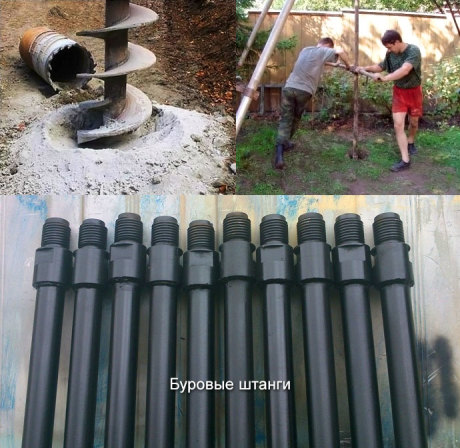
To drill a well with your own hands, you must have a set of tools: a collar, a drill, nozzle rods, open-end wrenches. The work is hard and unproductive. A stone the size of a fist or more, caught in the way, will nullify all efforts
It is difficult not only to rotate the gate, but also to raise the drill to install additional rods. This task can be facilitated by hanging the drill on a cable through the pulley to the tripod.
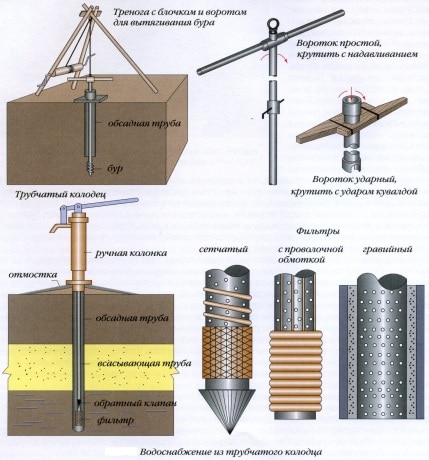
A simple combination of a tripod and a lifting block will help you lift the drill on a cable, which will at least partially facilitate the work
- A manual soil gas drill will achieve similar results, only faster and with less labor. You can rent a motor drill, you should choose a two-handed model with an engine with a power of at least 1 kW, you will also need a set of extension nozzles. It is necessary to work with such a device together, it is difficult to keep it straight alone.
How to drill a well under water using a small-sized drilling rig
The main disadvantage of manual drilling is the inability to go to a considerable depth. The reasons for this are the inability to develop a significant effort, and keep the drill evenly, without distortions. The problem is solved by installing more powerful engine on a sturdy frame that is not subject to displacement. The engine can be gasoline or electric, the more powerful, the higher the capabilities of the device. Frame - to have a mechanism for lifting the drill and installing nozzles, this will allow you to reach depths much greater than if the work was done manually. There are craftsmen who make such equipment with their own hands, since the design is simple.
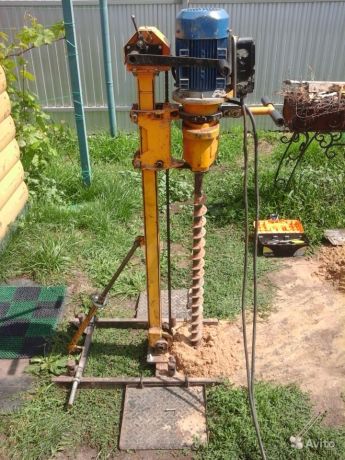
The simplest home-made drilling rig: a frame with a support platform, a movable platform with an engine is fixed on it
But there are also quite productive factory small-sized drilling rigs (MBU) that can be rented.
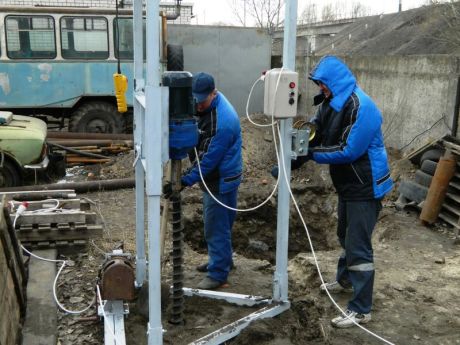
MDR with a powerful electric motor and a stable frame allows drilling to a fairly large depth. Of course, this is already quite complex equipment, but renting it is still much cheaper than attracting a full-fledged installation based on a truck.
The passport indicates the maximum drilling depth depending on the type of soil and the diameter of the drill. How to drill a well for water using an MBU? The operation of the device is monitored by one operator, assistants are needed only to bring it to the construction site and install it. In soils that do not contain stony inclusions, using a small-sized installation, depending on its model, it is possible to drill a well with a depth of 20 to 50 m. Most likely, this will make it possible to arrange water intake for groundwater sand, and if you're lucky - high-quality interstratal ones.
How to punch a well with your own hands without drilling
There is also a method percussion drilling when a heavy pointed chisel is dropped into the well, breaking the rock. It is fixed on a steel cable, which, in turn, is wound on a shaft with a stopper or fixed on a block. This whole structure must be fixed on a rather high tower, its overall dimensions are larger than those of the MBU. The reciprocating movement of the bit can be provided by the engine or the cable is wound and released manually. Of the advantages of the shock-rope method, one can name the possibility of well construction large diameter and the ability to work in fairly hard rocks. However, the small depth of drilling and the very low rate of work make this method of little demand.
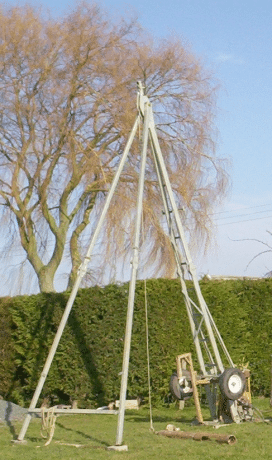
How to pierce a well with your own hands using the shock-rope method? You will need a tripod with a block or shaft, a cable, a chisel and lifting mechanism. The installation height is greater, the deeper it is planned to "hollow" the water intake
- Equipment manufacturers and craftsmen who contract to perform work often use the hydrodrilling method. The video below shows how a well is drilled for water, pumping liquid into it and removing it along with soil particles. The water acts as a lubricant, thus almost doubling the drilling depth. However, along with the liquid from the surface, harmful microflora is inevitably introduced into the aquifer, which can lead to contamination of clean groundwater. If the water intake is done to obtain drinking water, it is advisable not to use the hydromethod, but to drill "dry". When this cannot be avoided, it is necessary immediately after completion of work to install a casing pipe with a filter, lower it into the well vibration pump and continuously pump the water intake for at least a week. If this is not done, the source will have to “treat” for a long time.
- When installing nozzles on the drill, follow the safety precautions in the most strict way, otherwise you risk being left without fingers.
Video: how to drill a well for water
Pretty powerful semi-automatic small installation"Mole", shows step by step how to drill a well for water.
It is clearly shown how to punch a well with your own hands, using a motor drill with nozzles.
You can try to drill and equip a well for water supply on your own if you have certain skills, time and desire. In the absence of such, entrust the task to professional geologists, competent specialists will first determine the approximate depth of occurrence various types water, offer options for the device of water intake, perform well drilling, installation of the production string. They will pump the source, determine the characteristics, issue a passport and give a guarantee for the work performed.
In any private house or cottage there should be water. It is necessary for household needs, as well as for irrigation of crops. Despite the fact that drilling wells under water with your own hands at first glance seems like a grandiose process, this task is actually quite feasible. Of course, some special tools will be required to solve this problem, but we are not talking about heavy drilling equipment. A well can be drilled in several ways, quite simple in execution.
What are well structures?
Water can be obtained different ways. The main types of wells for water production are:
- A well with a good spring that quickly fills up with water and is able to accumulate up to 2 m² of water.
- A well-filter in the sand in the form of a pipe with a diameter of 100 mm, immersed by an auger to a depth of 20-30 m. The buried end of the pipe is equipped with a stainless steel filter, immersed in coarse sand. Such wells can last up to 15 years.
- Artesian well in porous limestone with a depth of 20 to 100 m. This well is filterless, its service life is up to 50 years.
The exact depth of the future well cannot be determined in advance. You should be guided by the depth of wells drilled in areas near neighbors, or nearby wells. Given the possible deviations associated with the uneven occurrence of soil layers, it is better to buy casing pipes, focusing on the water supply sources already equipped on the site, taking into account small adjustments. Of course, in this way you will not get the most delicious water, but you will provide yourself with the necessary supply of water resources.
You should be aware that with intensive operation of the well, it will last much longer than with infrequent use.
Manual well drilling
by the most in a simple way water well drilling is rotary, in which the well is made with a rotating drill.
Before starting work, you should prepare a drill, a drilling derrick, a winch, casing pipes and rods. A deep well should be dug with a drill rig, which helps to lower and raise the drill with rods.
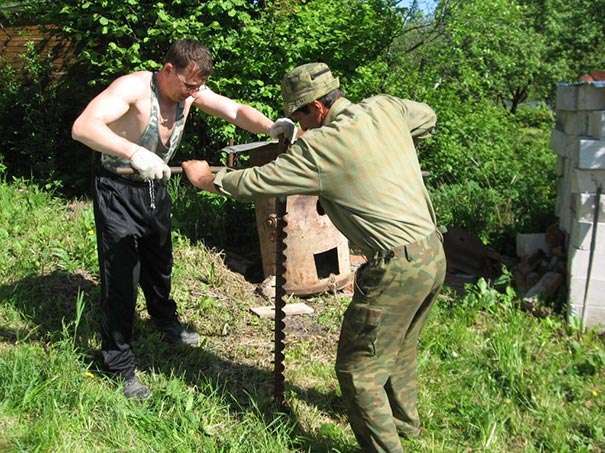
If the hole to be drilled is not very deep, then a derrick may not be required (when the drill string is pulled by hand). For the manufacture of drill rods, pipes can be used, and the connections of products can be threaded or keyed.
For the manufacture of cutting nozzles, 3 mm sheet steel is used. When sharpening the edges of the nozzles, keep in mind that during the rotation of the drill it is necessary that they cut into the ground in a clockwise direction.
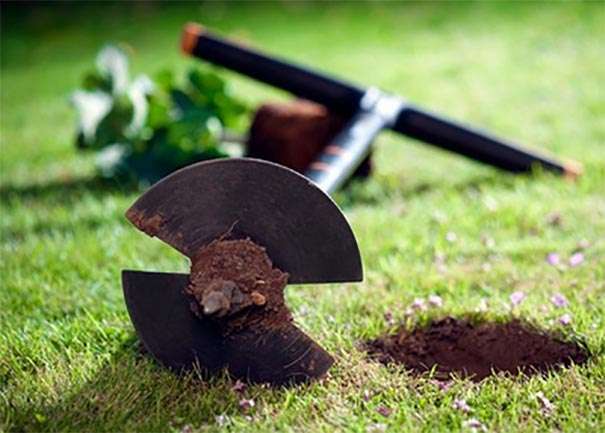
Many homeowners are familiar with the simplest drilling device. The same principle is used for well drilling.
- Having determined the place where drilling will be carried out, a tower should be installed above it. At the same time, its height should be higher than the drill rod, since this approach will greatly simplify the lifting and extraction of the rod.
- Next, you should dig a recess with a shovel for several bayonets, which will guide the drill.
- To carry out the first turns with a drill, special efforts are not required, so one person can do it. But after, when the pipe begins to sink deeper, an assistant will be required.
- If the drill fails to pull out the first time, turn it counterclockwise and then try again.
- The deeper the drill sinks into the ground, the more difficult it will be to rotate the pipe. To facilitate the work, you need to soften the soil with water. By moving the drill down every half meter, the drilling structure is brought to the surface and cleared of the ground.
- As the drill handle is compared with the ground level, it is necessary to build up the structure with the help of an additional elbow.
- Since raising and cleaning the drill takes a significant part of the time, use the maximum capacity of the design - grab and extract as much earth as possible to the surface.
- If the work is carried out on loose soil, install additional casing pipes in the well to prevent the earth from falling off the walls of the drilled well and blocking it.
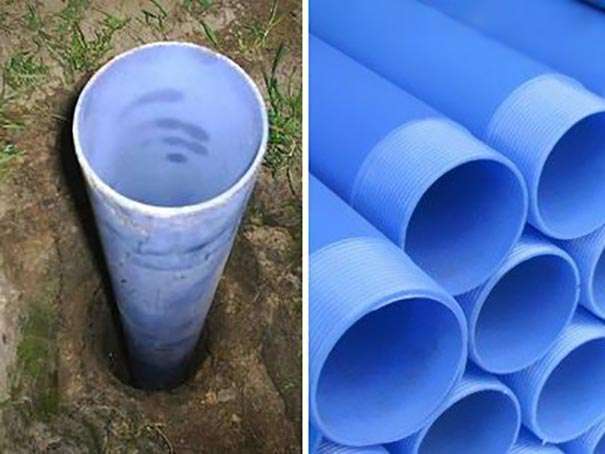
- It is necessary to drill until the drilling device reaches the aquifer. Its presence can be easily determined by appearance delivered land.
- In the aquifer, the drill should be immersed even further until it rests against the water-resistant layer - this is necessary to ensure maximum water flow into the well. It should be noted that manual drilling is possible only if the depth of the well is no more than 20 meters.
- Next, you need to pump out dirty water using a manual or submersible pump. Removing two or three buckets dirty water, the aquifer should be washed, after which it should appear pure water. If water does not appear, deepen the well a couple more meters.
Video about drilling wells under water with your own hands
Well drilling
Another drilling method wells with water under pressure with their own hands. This drilling method is applicable for any type of soil: both sandy and clay. However, for stony soil, other methods should be used.
To do the job, you need a drilling rig of small size, strength and time. If a boulder does not get in the way of the drilling rig, and also if the aquifer is not very deep below ground level, then the work can be done in just a few hours.
This work can be done independently, without resorting to the help of a partner. It is not necessary to purchase a drilling rig, it can also be rented.
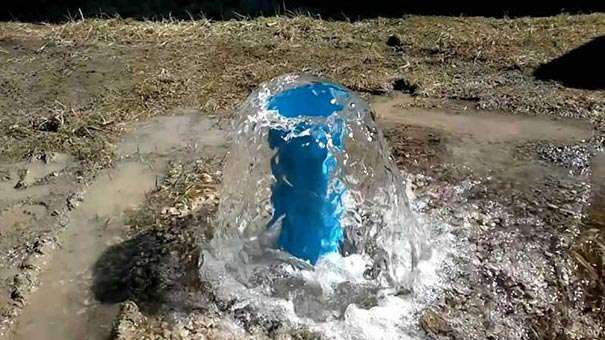
- Before starting drilling, according to the instructions, it is necessary to dig several technological pits at a distance of 1-1.5 meters, which are necessary to perform the function of a pit-filter.
- The pits should be square in shape, 0.7 x 0.7 m in size. The main pit is located a little further, and they should communicate with each other by a shallow trench. The size of the main pit is 1 x 1 x 1 m.
- The water pump should be located further from the main pit.
- Then you need to take the hose and lower its inlet into the main pit, and the outlet should be extended to the drilling rig.
- When everything you need is ready for work, we drill a well under the water with our own hands. Water pump at the same time, it supplies the solution to the hoses, which enters the rods through the swivel, and then down to the drill tip. The most powerful pressure of the liquid washes out the rocks destroyed by the drill bit and displaces them to the surface of the well.
- The spent clay solution enters the filter pit, where heavy, destroyed rocks sink to its bottom, and the liquid flows through the trench again to the main pit, and then to the drill tip.
- Thus, the water solution is circulated, and with each circle there is a washing out and cleaning from the sludge.
- As the drill sinks deeper into the soil layers, the rod should be increased.
- Drilling continues until clean water appears on the surface. This means that the drill has reached the water layer.
- Then it is necessary to flush the water intake, and place a water pump in the well.
After several weeks of operation, it is necessary to hand over the water for analysis, take the necessary measurements, issue a well passport, which should contain such characteristics as depth, water level height, its debit and other indicators.
Video on how to drill a well under water with your own hands
Well repair
Further, during the operation of the well, over time, clogging of the filter may occur. In addition, if the pipeline is not used regularly, sand can become compacted in it, which can cause the well to become inoperable.
To repair the well, the contaminated filter is taken out and cleaned on its own, but in case of problems with the pipe, it is better to call qualified specialists who will flush the well.
Would you like to make a well on the site with your own hands? Or do you trust professional drillers more? Share your opinion in








